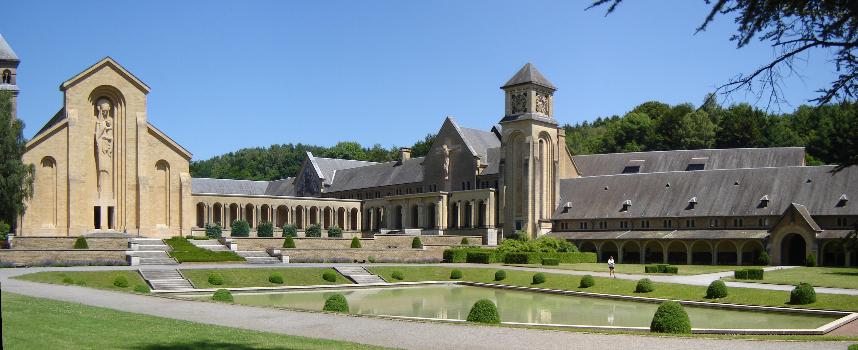General Information
| Completion: | 1948 |
|---|---|
| Status: | in use |
Project Type
| Function / usage: |
Monastery |
|---|
Location
| Location: |
Villers-devant-Orval, Luxembourg, Wallonia, Belgium |
|---|---|
| Coordinates: | 49° 38' 24.57" N 5° 20' 58.04" E |
Technical Information
There currently is no technical data available.
Excerpt from Wikipedia
Orval Abbey (Abbaye Notre-Dame d'Orval) is a Cistercian monastery founded in 1132 in the Gaume region of Belgium and is located in Villers-devant-Orval, part of Florenville in the province of Luxembourg. The abbey is well known for ist history and spiritual life but also for ist local production of the Trappist beer Orval and a specific cheese.
History
First foundation
The site has been occupied since the Merovingian period, and there is evidence that there was already a chapel here in the 10th century. In 1070, a group of Benedictine monks from Calabria settled here, at the invitation of Arnould, Count of Chiny, and began construction of a church and a monastery, but after some forty years, possibly because of the death of Count Arnould, they moved away again. They were replaced by a community of Canons Regular, who completed the construction work: the abbey church was consecrated on 30 September 1124.
In 1132, a group of Cistercian monks from Trois-Fontaines Abbey in Champagne arrived, and the two groups formed a single community within the Cistercian Order, under the first abbot, Constantin.
Around 1252, the monastery was destroyed by a fire; the rebuilding took around 100 years.
In the literary field the monks of Orval did not much distinguish themselves. The only noteworthy writer was Aegidius or Gilles d'Orval, who lived in the first half of the thirteenth century. He wrote the continuation, to the year 1251, of the "Gesta Pontificum Leodiensium", which had been written up to the year 1048 by Heriger of Lobbes and Anselm of Liège (Mon. Germ. Script., XXV, 1-129).
During the 15th and 16th centuries, the various wars between France and various neighbouring regions (Burgundy, Spain) had an important impact on Orval. At one stage a foundry was established on the site. In 1637, during the Thirty Years' War, the abbey was pillaged and burnt by French mercenaries.
In the 17th century, the abbey converted to the Trappist branch of the Cistercian order, but reverted to the Rule of the main order in around 1785.
In 1793, during the French Revolution, the abbey was completely burnt down by French forces, in retaliation for the hospitality it had provided to Austrian troops, and the community dispersed.
Second foundation
In 1887, the land and ruins were acquired by the Harenne family. They donated the lands to the Cistercian order in 1926 so that monastic life could resume on the site. Between 1926 and 1948, under the direction of the Trappist monk Marie-Albert van der Cruyssen, the new monastery was constructed, and in 1935 Orval regained the rank of abbey. On 8 September 1948, the new church was consecrated. The abbey has lots of artifacts designed and produced by Camille Colruyt.
The ruins of the medieval buildings remain on the site and are available to view.
Text imported from Wikipedia article "Orval Abbey" and modified on July 23, 2019 according to the CC-BY-SA 4.0 International license.
Participants
Currently there is no information available about persons or companies having participated in this project.
Relevant Web Sites
Relevant Publications
- (1949): L'abbaye d'Orval. In: La Technique des Travaux, v. 25, n. 3-4 (March 1949), pp. 76-90.
- About this
data sheet - Structure-ID
20052470 - Published on:
01/02/2010 - Last updated on:
24/03/2021





